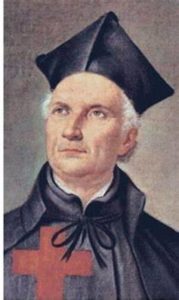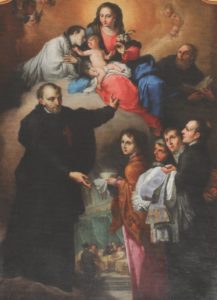Fr. Gianfranco Lunardon
 Pope Francis, in his apostolic letter, addressed to all religious on the occasion of the Year of Consecrated Life (November 28, 2014), invited us to come to terms with our history and memory, cultivating a deep sense of gratitude. “In this Year, it will be appropriate for each charismatic family to remember its beginnings and its historical development.” Telling one’s story is indispensable for keeping one’s identity alive and strengthening the unity of the family and the sense of belonging of its members. It is not a question of making archaeology or cultivating useless nostalgia, but instead of retracing the path of past generations to grasp in it the inspirational spark, the ideals, the projects, the values that moved them, beginning with the Founders, the Foundresses, and the first communities. It is also a way to become aware of how the charism has been lived throughout history, what creativity it has unleashed, what difficulties it has had to face, and how they have been overcome. One can discover inconsistencies, the fruit of human weaknesses, and perhaps even the oblivion of some essential aspects of the charism. Everything is instructive and, at the same time, becomes a call to conversion. To tell one’s story is to give praise to God and to thank him for all his gifts”.
Pope Francis, in his apostolic letter, addressed to all religious on the occasion of the Year of Consecrated Life (November 28, 2014), invited us to come to terms with our history and memory, cultivating a deep sense of gratitude. “In this Year, it will be appropriate for each charismatic family to remember its beginnings and its historical development.” Telling one’s story is indispensable for keeping one’s identity alive and strengthening the unity of the family and the sense of belonging of its members. It is not a question of making archaeology or cultivating useless nostalgia, but instead of retracing the path of past generations to grasp in it the inspirational spark, the ideals, the projects, the values that moved them, beginning with the Founders, the Foundresses, and the first communities. It is also a way to become aware of how the charism has been lived throughout history, what creativity it has unleashed, what difficulties it has had to face, and how they have been overcome. One can discover inconsistencies, the fruit of human weaknesses, and perhaps even the oblivion of some essential aspects of the charism. Everything is instructive and, at the same time, becomes a call to conversion. To tell one’s story is to give praise to God and to thank him for all his gifts”.
In this context of remembrance, remembering Fr. Camillo Cesare Bresciani as Alter Camillus and as Second Founder brings us back into a solid historical reality. At the end of his life, at the age of 88, on July 20, 1871, he left to our Camillian Order a spiritual and reforming legacy that, without hesitation, has always been considered as important as that of Camillus de Lellis.
The wars that had already seen several times the Camillian religious compact and in the front line on the various fronts, in the service to the wounded and dying at the end of the eighteenth century and in the first half of the nineteenth century, perturb the Camillian Order. In 1810, together with other religious Orders, the superior general Michelangelo Toni was imprisoned and deported to Paris and Corsica. In 1814 he was released and began, with the consent of Pope Pius VII, a refounding of the Order, reconnecting all possible contacts with the brothers in diaspora, reanimating the desperate. By the time of his death in 1821, 22 communities had been ‘resurrected.’
This small “remnant” of the Order had to face the cholera epidemic in Italy in 1835. Although few in number, the Camillians were present as always in every lazaret (marine quarantine facility), active, ready to give their lives, according to the spirit of the fourth religious vow. In this period of great social tensions, a new figure appears in the Order, Don Cesare Bresciani, a diocesan priest from Verona, where he was born in 1783.
He, a brilliant poet and orator, has chosen with determination to commit himself in the Veronese lazarets in assisting the cholera victims which contaminated the city in 1836. He reads with attention and passion the life of Camillus de Lellis. He meditates on it. It was not easy to imitate, but it has its own overwhelming charm. Like St. Camillus, he has a passion for the poor, the sick, and the suffering. He is a member of the “Sacra Fratellanza dei Preti e Laici Spedalieri” (Holy Brotherhood of Spedalieri Priests and Laymen), which gathers together charitable and generous Veroneses who assist the sick free of charge in their spiritual and corporal needs.
1836. He reads with attention and passion the life of Camillus de Lellis. He meditates on it. It was not easy to imitate, but it has its own overwhelming charm. Like St. Camillus, he has a passion for the poor, the sick, and the suffering. He is a member of the “Sacra Fratellanza dei Preti e Laici Spedalieri” (Holy Brotherhood of Spedalieri Priests and Laymen), which gathers together charitable and generous Veroneses who assist the sick free of charge in their spiritual and corporal needs.
Don Cesare Bresciani also created a group of priests, some students of philosophy, and laypeople, living in a small, very frugal house. While the priests assisted the sick spiritually, the laypeople, like nurses, took turns day and night to meet their health needs. In 1837, he wrote to Fr. Luigi Togni, superior general of the Camillians, declaring: “We are Camillians without having seen them. Our Rule is the life of St. Camillus that we read every day. We can say that our vocation came to us through reading. We work day and night. We dress and eat simply.“
A sort of Camillian presence had grown in Verona without the Camillians, in an environment oriented to raise institutes of mercy and charity, as evidenced by the painting of Canon Agostino Ugolini, recently recovered and restored by the Camillians in Verona. In April 1828, Don Bresciani, already a major chaplain at the public hospital, was called to take over the spiritual direction of the Hospice of Verona (which housed more than 700 patients), in agreement with the hospital management, the Commission of public charity (created in 1817) and the vicar general of the curia of Verona.
After having participated in the realization of a house for the abandoned children in 1829, at the end of 1830, Bresciani had to face, together with the public authorities and the Veronese charity, the arrival of the first cases of cholera “together with frequent cases of smallpox and petechial typhus,” destined to re-explode in the spring of the following years, reviving the emulation of the Camillian experience of helping the sick at the risk of one’s own life.
“There are two ways open to the ministry of the sick, the material and the spiritual, by which the pious Camillian must not walk but run. The object, to which both of arms and chest, of stole and sacred charisms he aspires, is always the sick person whom he represents and represents himself in a deep and mysterious incredible aesthetics, but still real (with human piety and divine charity) because he is a God who hides in the rags and veils of the poor sick and dying[ …] Charity will divine your steps.”
The constitutive traits of the rebirth and of the actuality of the Camillian charism, which emerged linearly and straightforwardly, are the spiritual and charismatic profile, the communitarian and obedient involvement in the institution, the simultaneous attention to the spiritual care, and corporal dedication to the sick person in a profound fidelity through which Fr. Bresciani knew how to go beyond personal mentalities and formal schemes, lived at times with suffering in all sincerity, but which brought its fruits assuring the presence of the Lord.
The recrudescence of cholera and petechial typhus would be dramatic in Verona until 1850, as well as cholera in 1855, which would put the Veronese Camillian foundation to the test. Many confreres died in assisting the infected while writing pages of visible and authentic charity that take us directly back to our beginnings, to the very biography of Saint Camillus. A young cleric complained to Fr. Luigi Artini that he had not been chosen for direct assistance to the cholera victims. In 1855, Bro. Giuseppe Rossini died among the first infected. Fr. Bresciani describes the spirit with which he lived and died. “Providence wanted him to be a victim of charity in Verona so that here, the root of the esteem of our ministry of charity could be planted, where the plant received its first watering from the earth and from the sky to expand in our Lombardian-Venetian districts.”
 As it often happens in life, even the highest ideals have to face the straits of history. The ideal impulses and tensions of the beginnings have to suffer their inevitable immersion in modern contemporaneity ad intra and ad extra and the tensions in pre-unification Italy and the placement of provincial identity in the new ‘homeland.’
As it often happens in life, even the highest ideals have to face the straits of history. The ideal impulses and tensions of the beginnings have to suffer their inevitable immersion in modern contemporaneity ad intra and ad extra and the tensions in pre-unification Italy and the placement of provincial identity in the new ‘homeland.’
Bresciani’s intention was to join the Order of St. Camillus but with something new. For this, he needed the permission of the superior general in Rome, the bishop of the curia of Verona, the Holy See, the Austrian government since Verona was part of the Habsburg Empire.
It will be above all the clashes and mediations of perspective between the center – the central government in Rome – and the periphery of the Order that will shake and severely test Fr. Bresciani until he reaches an honorable compromise between the provincial plan and the national leadership for the Lombardy-Venetian province that nationalizes the Order and an Order that orients the Province itself.
The relationship between ‘Rome’ and the Camillian foundation in Verona is difficult to define in its details. It indeed varied according to the religious who succeeded one another in governing the Order. General Fr. Luigi Togni described the Camillian houses of Verona as the “consolation of his heart.” Fr. Camillo Guardi, then Vicar General and later Superior General, spoke of the Bresciani foundation as “wheat transplanted in the Veneto region to make our Holy Religious Institute sprout […] and now it has become a solid plant, with many branches, rich in leaves and, what is most important, luxuriant and full of fruit.” Attitudes changed for the worse, and tensions escalated with the papal appointment as superior general of the Order of Fr. Francesco Italiani. He, among other things, was the novice master of Fr. Bresciani in Casale Monferrato.
Despite the misunderstandings that arose between the foundation in Verona and the General Curia in Rome, accompanied by distrustful news that was not always true, Fr. Bresciani did not hesitate to continue the reform of the Camillian charism, with the intimate peace of one who always sought God’s plan, piety towards the poor and the sick and harmony among religious.














Camillians on Facebook
Camillians on Twitter
Camillians on Instagram